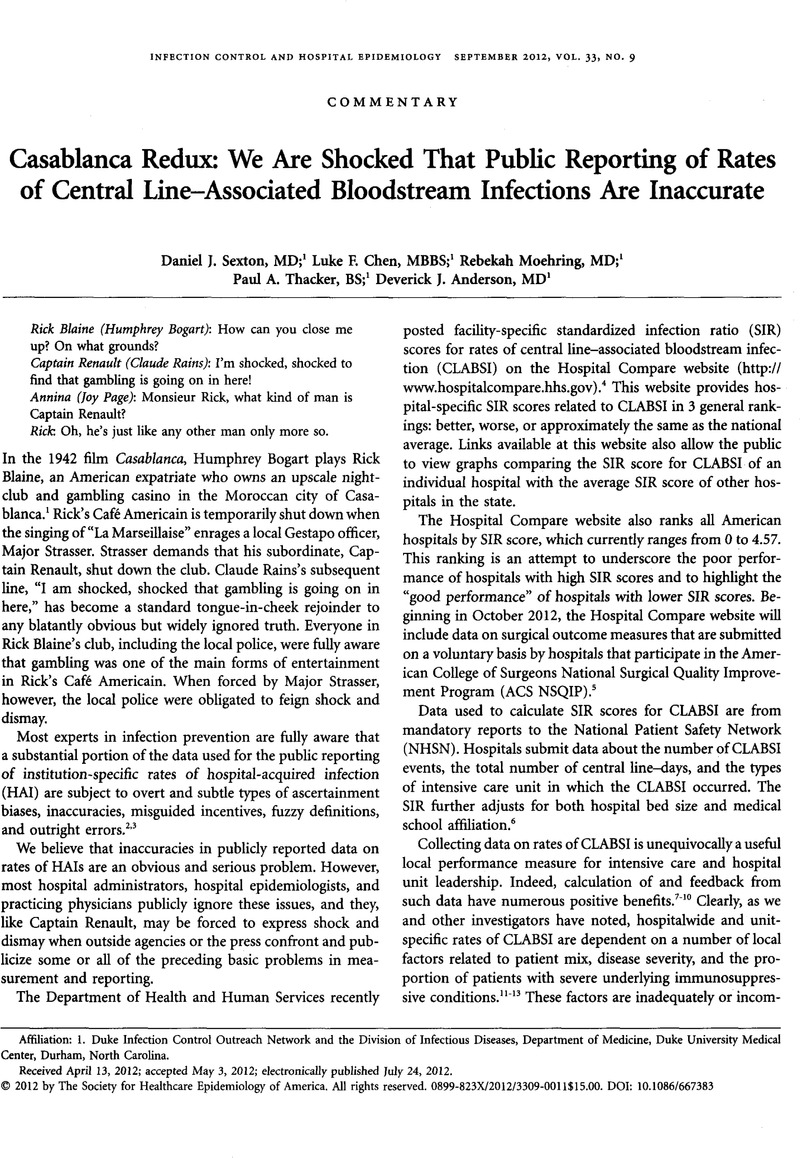Crossref Citations
This article has been cited by the following publications. This list is generated based on data provided by Crossref.
Søgaard, Mette
Lyytikäinen, Outi
Laupland, Kevin B
and
Schønheyder, Henrik Carl
2013.
Monitoring the epidemiology of bloodstream infections: aims, methods and importance.
Expert Review of Anti-infective Therapy,
Vol. 11,
Issue. 12,
p.
1281.
Steinberg, James P.
and
Coffin, Susan E.
2013.
Improving the Central Line—Associated Bloodstream Infection Surveillance Definition: A Work in Progress.
Infection Control & Hospital Epidemiology,
Vol. 34,
Issue. 8,
p.
777.
Leekha, Surbhi
Li, Shanshan
Thom, Kerri A.
Preas, Michael Anne
Caffo, Brian S.
Morgan, Daniel J.
and
Harris, Anthony D.
2013.
Comparison of Total Hospital-Acquired Bloodstream Infections to Central Line–Associated Bloodstream Infections and Implications for Outcome Measures in Infection Control.
Infection Control & Hospital Epidemiology,
Vol. 34,
Issue. 9,
p.
984.
McGregor, Jessina C.
and
Harris, Anthony D.
2014.
The Need for Advancements in the Field of Risk Adjustment for Healthcare-Associated Infections.
Infection Control & Hospital Epidemiology,
Vol. 35,
Issue. 1,
p.
8.
Weaver, Sallie J.
Weeks, Kristina
Pham, Julius Cuong
and
Pronovost, Peter J.
2014.
On the CUSP: Stop BSI: Evaluating the relationship between central line–associated bloodstream infection rate and patient safety climate profile.
American Journal of Infection Control,
Vol. 42,
Issue. 10,
p.
S203.
Podolsky, Daniel K.
Nagarkar, Purushottam A.
Reed, W. Gary
and
Rohrich, Rod J.
2014.
Public Reporting of Patient Safety Metrics.
Plastic and Reconstructive Surgery,
Vol. 134,
Issue. 6,
p.
981e.
Harris, Anthony D.
Fleming, Brandon
Bromberg, Jonathan S.
Rock, Peter
Nkonge, Grace
Emerick, Michele
Harris-Williams, Michelle
and
Thom, Kerri A.
2015.
Surgical Site Infection after Renal Transplantation.
Infection Control & Hospital Epidemiology,
Vol. 36,
Issue. 4,
p.
417.
Rupp, Mark E.
and
Majorant, Denisa
2016.
Prevention of Vascular Catheter-Related Bloodstream Infections.
Infectious Disease Clinics of North America,
Vol. 30,
Issue. 4,
p.
853.
Rock, Clare
Thom, Kerri A.
Harris, Anthony D.
Li, Shanahan
Morgan, Daniel
Milstone, Aaron M.
Caffo, Brian
Joshi, Manjari
and
Leekha, Surbhi
2016.
A Multicenter Longitudinal Study of Hospital-Onset Bacteremia: Time for a New Quality Outcome Measure?.
Infection Control & Hospital Epidemiology,
Vol. 37,
Issue. 2,
p.
143.
Hota, Bala
Malpiedi, Paul
Fridkin, Scott K.
Martin, John
and
Trick, William
2016.
Probabilistic Measurement of Central Line–Associated Bloodstream Infections.
Infection Control & Hospital Epidemiology,
Vol. 37,
Issue. 2,
p.
149.
Martín-Rabadán, P.
Pérez-García, F.
Zamora Flores, E.
Nisa, E.S.
Guembe, M.
and
Bouza, E.
2017.
Improved method for the detection of catheter colonization and catheter-related bacteremia in newborns.
Diagnostic Microbiology and Infectious Disease,
Vol. 87,
Issue. 4,
p.
311.
Civitarese, Anna M.
Ruggieri, Eric
Walz, J. Matthias
Mack, Deborah Ann
Heard, Stephen O.
Mitchell, Michael
Lilly, Craig M.
Landry, Karen E.
and
Ellison, Richard T.
2017.
A 10-Year Review of Total Hospital-Onset ICU Bloodstream Infections at an Academic Medical Center.
Chest,
Vol. 151,
Issue. 5,
p.
1011.
Harris, Anthony D.
Sbarra, Alyssa N.
Leekha, Surbhi
Jackson, Sarah S.
Johnson, J. Kristie
Pineles, Lisa
and
Thom, Kerri A.
2018.
Electronically Available Comorbid Conditions for Risk Prediction of Healthcare-Associated Clostridium difficile Infection.
Infection Control & Hospital Epidemiology,
Vol. 39,
Issue. 3,
p.
297.
Larsen, Emily N.
Gavin, Nicole
Marsh, Nicole
Rickard, Claire M.
Runnegar, Naomi
and
Webster, Joan
2019.
A systematic review of central-line–associated bloodstream infection (CLABSI) diagnostic reliability and error.
Infection Control & Hospital Epidemiology,
Vol. 40,
Issue. 10,
p.
1100.
Pek, Zachary
Canepa, Hannah
Gregg, Karen L.
Cabunoc, Marie K.
Leekha, Surbhi
and
Baghdadi, Jonathan D.
2023.
Recurrent central-line–associated bloodstream infection in a single high-risk patient.
Infection Control & Hospital Epidemiology,
Vol. 44,
Issue. 1,
p.
166.
Stack, Matthew A.
Dbeibo, Lana
Fadel, William
Kelley, Kristen
Sadowski, Joshua
and
Beeler, Cole
2024.
Etiology and utility of hospital-onset bacteremia as a safety metric for targeted harm reduction.
American Journal of Infection Control,
Vol. 52,
Issue. 2,
p.
195.



